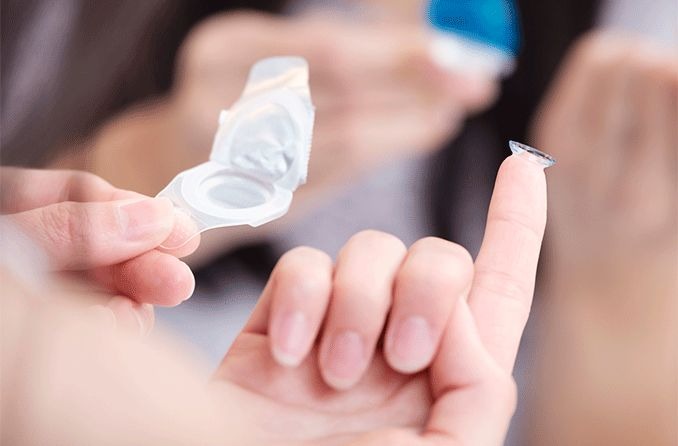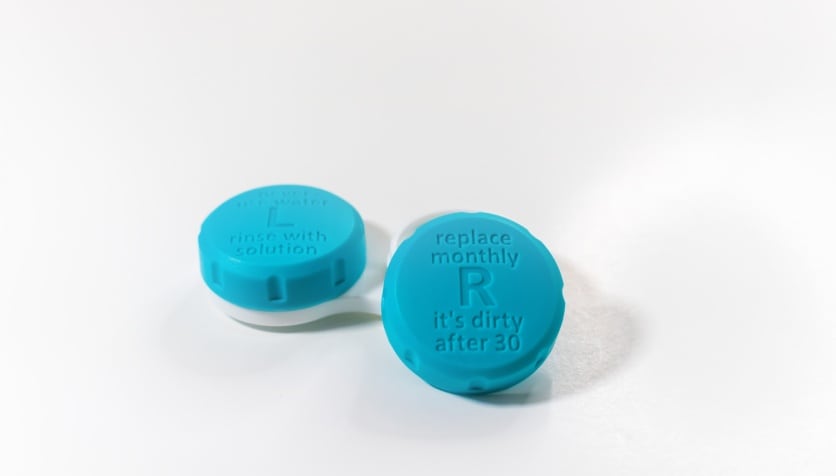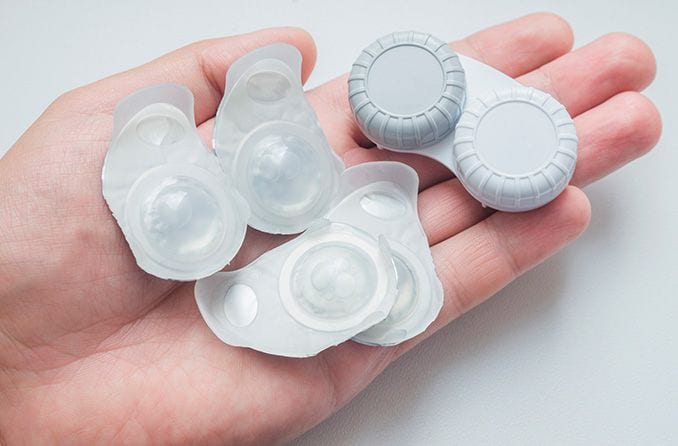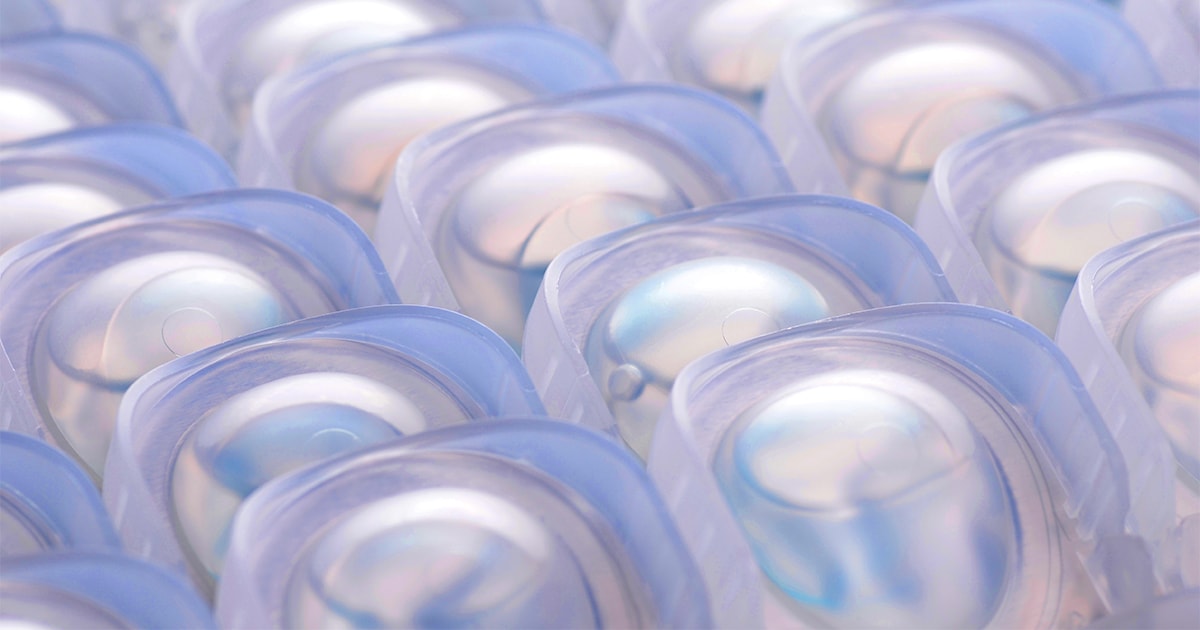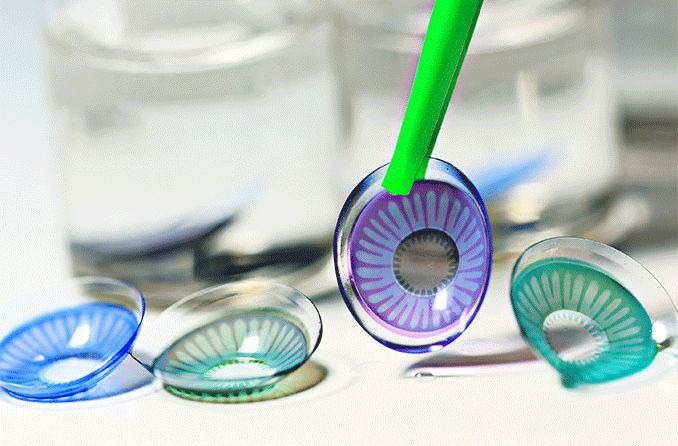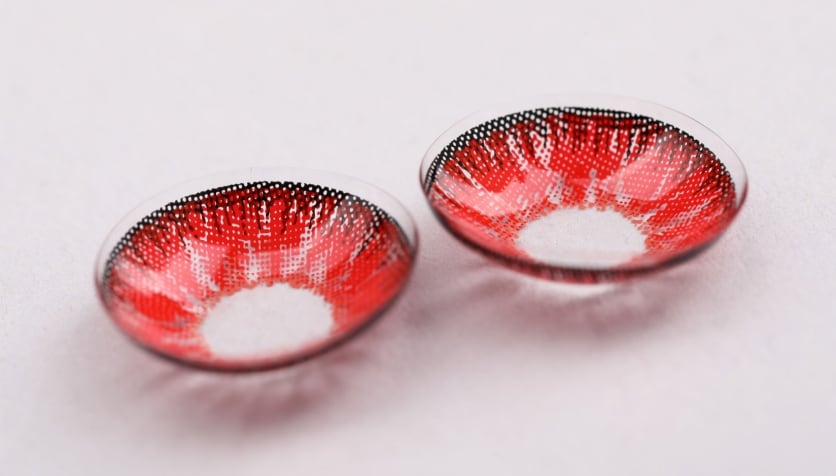Custom contact lenses may be for you if you can't wear regular contact lenses because of problems such as an irregularly shaped eye or too much astigmatism.
You also might consider custom contact lenses if regular contacts are uncomfortable or cause vision problems.
Custom-made contacts are available both in rigid gas permeable (RGP or GP) and soft lens materials, and may be able to provide sharper vision and greater wearing comfort than regular GP or soft lenses.
Gas Permeable Custom Contacts
Most eye care professionals agree that gas permeable contact lenses generally provide sharper vision than soft contacts. This especially is true for people with certain types of astigmatism.
But some people find gas permeable lenses difficult to get accustomed to. GP lenses are designed to create a slight gap between the edge of the lens and the eye's surface. This "edge lift" enables tears to flow behind the lens during and after blinks to provide more oxygen for eye health.
Unfortunately, the interaction between the edge of gas permeable lenses and the eyelid and the movement of GP lenses during blinks can make these lenses uncomfortable for some wearers.
Also, for individuals with unusually shaped corneas, it may be impossible to fit the eye properly with conventional GP lenses so the lenses remain properly centered on the eye. This increases the risk of discomfort and variable vision.
To overcome these limitations and enable more people to enjoy clear, comfortable vision with GP lenses, contact lens manufacturers are now using advanced technology to create customized gas permeable lens options.
The fitting and lens manufacturing process for gas permeable custom contact lenses differs from conventional GP lenses in two ways: how your eye is measured and how the lenses are designed.
Eye Measurements, Lens Designs For Conventional GP Lenses
Understanding how conventional GP lenses are fitted as part of a contact lens eye exam will help you understand the complexities of custom contact lenses.
Most eye care practitioners measure the curvature of the front surface of the cornea with an instrument called a keratometer.
The keratometer uses light reflections from the cornea to determine the steepest and flattest meridians of the eye. To picture how this works, imagine that the front of the eye is like the face of a clock. A line connecting the 3 and the 9 is one meridian; a line connecting the 12 and 6 is another meridian, and so on.
The curvature of a conventional GP contact lens is based on three keratometry easurements: the curve of the steepest meridian of the cornea, the curve of the flattest meridian and the orientation of the flattest meridian — in other words, whether the flattest meridian is horizontal, vertical or somewhere in between.
Based on these measurements, the eye care practitioner or lens manufacturer chooses the curves to apply to the back surface of the GP lens for the best possible fit. With a conventional GP lens, the back surface typically has one curve for the central part of the lens (called the base curve) and two or more flatter curves in the periphery of the lens.
These flatter curves help the lens align better to the surface of the cornea, which typically becomes flatter in the periphery. The peripheral curves also provide the proper amount of edge lift so tears can circulate behind the surface of the lens during and after blinks.
Eye Measurements, Lens Designs For GP Custom Lenses
Compared with conventional methods, the eye measurements and lens designs for custom gas permeable lenses are much more complex.
Instead of obtaining just three measurements of the cornea from a keratometer, the eye care practitioner who fits GP custom contact lenses uses an instrument called a corneal topographer to obtain curvature data from several thousand reference points on the eye.
These data points form a detailed map of the curvature of the eye, which the eye care practitioner and lens manufacturer then use to design a multi-curved lens surface that conforms much more closely to the surface of the cornea.
This customized design and fitting process creates a more comfortable fit — especially on irregularly shaped corneas and corneas with high degrees of astigmatism.
In addition to being produced with advanced lens fabrication equipment capable of creating surfaces with smoother point-to-point curvature changes, custom GP lenses typically are made with newer gas permeable lens materials that allow more oxygen to pass through the lens to the eye.
Because these newer materials allow more oxygen to reach the eye directly through the lens, eye care practitioners and contact lens manufacturers do not have to rely on tears pumping underneath the lens to maintain eye health. Therefore, the edge lift of customized lenses can be safely reduced and the curvature of the edge of the lenses can conform better to the peripheral cornea for a more comfortable fit.
Who Can Benefit From GP Custom Contact Lenses?
Nearly anyone who is dissatisfied with their vision with conventional soft contacts or who has tried conventional GP lenses and found them uncomfortable may be a good candidate for GP custom contact lenses.
And because custom GP lenses can be fabricated to fit unusual corneal surfaces, they often are an excellent solution for individuals with keratoconus or unusual corneal curvature — from natural causes, an eye injury or from an unsuccessful LASIK procedure or other corneal refractive surgery.
Also, multifocal custom gas permeable contact lenses are showing great promise for the correction of presbyopia. And some eye care practitioners report that custom GP lenses are more effective than conventional GP lenses for orthokeratology — a non-surgical treatment for myopia and astigmatism.
Soft Custom Contact Lenses
Though most custom contact lenses currently are made of rigid gas permeable lens materials, custom lenses also are available in soft lens materials, including new highly oxygen-permeable silicone hydrogel polymers.
A number of contact lens manufacturers offer special design soft contacts for hard-to-fit eyes. These designs feature smaller and larger diameters and a wider range of curvatures and powers than conventional soft lenses for a more customized fit. Some of these manufacturers also offer custom toric contact lenses that correct higher amounts of astigmatism than conventional soft toric lenses.
Most conventional toric soft lenses can correct only up to 2.50 diopters (D) of astigmatism and are available in astigmatism-correcting power increments of 0.50 or 0.75 D. Custom toric soft lenses can correct much higher amounts of astigmatism and can be ordered in finer increments (0.25 D) for a more accurate correction and potentially sharper vision.
Other types of custom soft contact lenses include:
- Multifocal toric contact lenses that can correct virtually any combination of refractive errors and presbyopia.
- Multifocal lenses specially designed for myopia control in children.
- Custom lenses made of advanced silicone hydrogel materials that are fabricated with a lathe-cut process similar to those used to create GP lenses for a nearly unlimited degree of customization.
Several contact lens manufacturers offer custom soft lenses for a wide variety of applications. During your contact lens exam, your eye doctor will determine whether you require custom lenses and explain which designs are best suited to your needs.
As with custom rigid GP lenses, fitting soft and silicone hydrogel custom contact lenses is more complex than a conventional contact lens fitting and often involves the use of special equipment to measure corneal topography and higher-order aberrations to assist in the design and fitting of the lenses.
Custom Contact Lens Care
Caring for custom contact lenses is no different than caring for conventional GP and soft lenses, and the same contact lens solutions can be used on custom lenses.
Custom contacts often are designed to be worn for longer periods between lens replacements than conventional contact lenses. This makes proper daily lens care even more important to keep the lenses clean and comfortable.
Be sure to consult with your eye doctor regarding the proper wearing time, replacement schedule and care products to keep your custom contacts comfortable and reduce the risk of contact lens-related complications.
Cost Of Custom Contact Lenses
Though custom contacts cost more than traditional soft or GP lenses, they have the potential of providing noticeably sharper vision than standard prescription contacts or eyeglasses. Custom contact lenses also are a good alternative to LASIK and other types of vision correction surgery, with no worries about LASIK risks or potential surgical complications.
Because of the added expertise, time and advanced equipment required to fit custom contact lenses, these made-to-order lenses typically cost significantly more than regular contact lenses. Your eye care professional can advise you of the cost of the particular type of custom lenses best suited for your needs.
To see if you're a good candidate for custom contact lenses, contact an eye doctor near you for a comprehensive eye exam and contact lens consultation.

